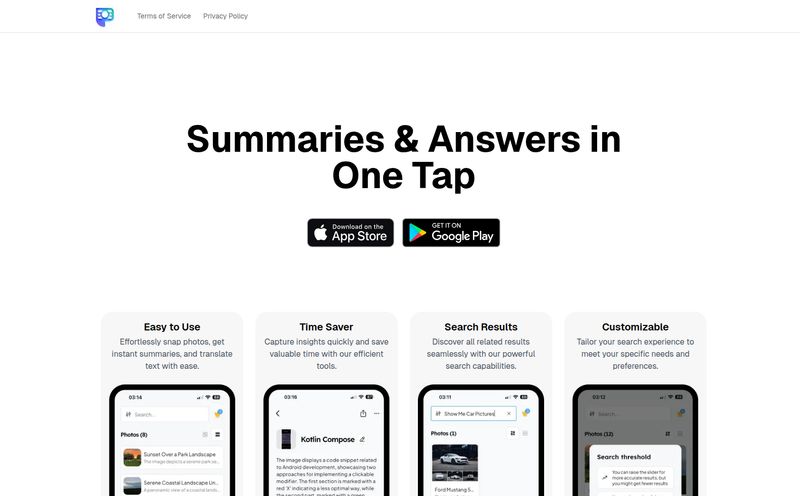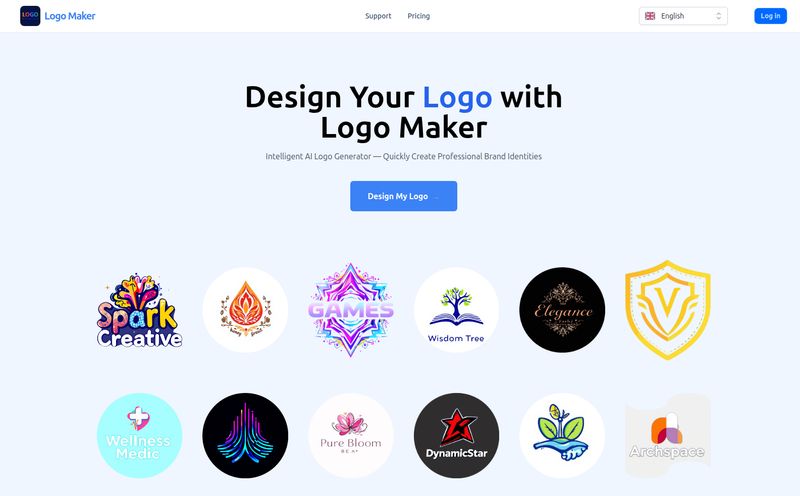If you've ever managed a global campaign, you know the soul-crushing pain of translating design files. It’s a special kind of hell. You have this beautiful poster or a slick UI mockup in Figma, and suddenly you need it in German, Japanese, and Spanish. Yesterday.
What follows is a workflow nightmare. You export the text, send it to a translator (or worse, Google Translate), get it back, and then begin the painstaking process of manually copy-pasting every. single. line. back into Photoshop or Illustrator. Text overflows, fonts break, and a piece of your sanity quietly floats away. I’ve been there. I’ve wasted entire afternoons on what felt like digital arts and crafts.
So, when I stumbled upon a tool called Translate.Photo, my inner, battle-scarred marketeer sat up and paid attention. It claims to translate entire design files—flyers, social posts, UIs—into over 75 languages with a single click. A bold claim. But could it actually be the digital Rosetta Stone we’ve been praying for?
So, What Exactly is Translate.Photo?
Think of Translate.Photo as a hyper-intelligent layer that sits on top of your favorite design software. It’s not just another translation app; it's an AI-powered engine built specifically for visual content. Using plugins for the big guns—Adobe Photoshop, Illustrator, InDesign, and Figma—it reads the text directly from your design, translates it, and then intelligently places it back, all while trying its best not to wreck your beautiful layout.

Visit Translate.Photo
The secret sauce, they say, is their “Contextual Translation Engine.” This isn’t just a word-for-word swap. The AI attempts to understand the context to maintain your brand’s voice and tone. A playful call-to-action shouldn't sound like a legal disclaimer in another language, and this tool aims to get that right. For anyone who has seen a clunky, literal translation kill a campaign’s vibe, you know how massive that is.
The Features That Made Me Look Twice
A lot of tools promise the world. I'm always more interested in the features that solve a real, tangible problem. Here’s what stood out to me.
The Dreamy One-Click Plugin Workflow
This is the main event. The ability to stay within Figma or Photoshop and just… click a button to get a translated version is a game-changer. It cuts out the middleman—the endless back-and-forth with spreadsheets and text files. This isn't just about saving time; it's about maintaining creative flow. You can iterate faster, test different languages, and get mockups to regional teams without derailing your entire day. It even supports Microsoft Word, which is a nice touch for those project briefs and content docs that often accompany design work.
Keeping Your Brand’s DNA Intact
Going global is pointless if your brand becomes unrecognizable. Translate.Photo includes a Translation Memory & Glossary. This is huge. It means you can set specific rules for your brand’s terminology. For instance, your unique product name or tagline should never be translated. You can lock that in. This ensures consistency across every single design, every single time. It's how you make sure your brand voice speaks with the same confidence in Berlin as it does in Boston.
Proofreading and Collaboration (Because AI Isn't Perfect)
Let's be honest, AI is amazing, but it's not infallible. Translate.Photo seems to understand this. They offer a Proofreading as a Service option. This is smart. It acknowledges that for a high-stakes campaign, you still want a native speaker to give it a final once-over. The tool gets you 95% of the way there in seconds, and then a human expert can easily come in and add that final polish. The platform also has collaboration tools, allowing you to invite team members or freelance translators directly to the project to approve or tweak the AI's work.
Let's Talk Money: The Pricing Breakdown
Alright, so how much does this magic cost? The pricing is structured in tiers, which I appreciate. It’s not a one-size-fits-all approach.
| Plan | Price | Best For |
|---|---|---|
| Free Plan | $0 | Individuals or small teams just wanting to try it out on a small project. You get 5,000 credits to play with. |
| Standard Plan | $19/month | Freelancers or small businesses who have regular, but not massive, translation needs. This gets you 50,000 credits and AI Bulk Translation. |
| Pro Plan | $99/month | Growing agencies and marketing teams. The credit limit jumps to 400,000 and you get 5 seats for your team. |
| Enterprise Plan | $199/month | Large organizations with heavy, ongoing multilingual projects. A massive 2 million credits and 10 seats. |
A quick note: The prices on their site might show promotional deals, so the Standard plan was listed at $9.5/mo when I checked. Also, the Professional Proofreading seems to be an add-on service across all plans, which makes sense. You pay for it when you need that extra layer of assurance.
The Good, The Bad, and The AI
No tool is perfect. In my experience, it’s all about whether the pros outweigh the cons for your specific needs.
On the plus side, the sheer speed and convenience are undeniable. The integration with Adobe and Figma is a massive win. Maintaining brand voice through the glossary and contextual AI is a sophisticated feature that shows they understand the core problem. And it genuinely makes global content creation more accessible for smaller teams.
However, you have to go in with your eyes open. You are still relying on an AI. For creative copy with lots of slang or cultural nuance, you’ll almost certainly want a human to proofread it. So, you should factor in the potential cost or time for that final review. And, of course, you're dependent on the plugin's compatibility with future versions of Adobe or Figma’s software, though that’s a common risk with any plugin-based workflow.
My Final Take as a Marketer
I've seen so many brilliant international marketing strategies get bogged down in the execution phase. A tool like Translate.Photo isn't just a utility; it's a bottleneck remover. It transforms the tedious, manual task of design localization into a streamlined, almost trivial part of the process.
Is it going to put human translators out of a job? No. I dont think so. But it will change their job. Instead of mind-numbing copy-pasting, their expertise can be focused on what really matters: ensuring cultural relevance and perfecting the creative nuance of the message. This tool handles the grunt work, freeing up humans to do the high-level strategic and creative thinking.
For any agency, marketing team, or even solo designer looking to expand their reach without expanding their headcount, this is definitely something to look into. It's one of the most practical applications of AI for creatives that I've seen in a while.
Frequently Asked Questions
- How accurate is the AI translation in Translate.Photo?
- It's very accurate for a machine, especially with its Contextual Translation Engine. However, for marketing copy with deep cultural nuance or humor, it's always best practice to have a native speaker perform a final review. The tool gets you about 95% of the way there instantly.
- Can Translate.Photo handle technical or industry-specific jargon?
- Yes, this is a key strength. Using the Translation Memory & Glossary feature, you can "teach" the AI your specific terminology, product names, and acronyms to ensure they are translated consistently and correctly—or not translated at all.
- Will translating the text mess up my design layout?
- The AI is designed to refit the translated text back into its original space intelligently. Since some languages are more verbose than others (looking at you, German), some minor manual adjustments to text boxes or font sizes might be needed, but it saves you from having to re-do the entire layout from scratch.
- What's the main difference between the Free and Standard plans?
- The Free plan is great for a trial run, giving you 5,000 credits. The Standard plan is the first paid tier, offering a much larger pool of 50,000 credits and unlocking the powerful AI Bulk Translation feature, which is essential for projects with multiple files.
- How secure is my content and design data?
- According to their FAQ, they take security seriously. Since you're working with potentially sensitive pre-launch campaign materials, it's always good practice to check their latest privacy policy, but they are built for professional teams and that generally means robust security protocols are in place.
- Can I use my existing glossary or translation memory with this tool?
- The platform has its own built-in Translation Memory & Glossary. You would likely need to populate it with your existing terms. This initial setup is a small price to pay for long-term consistency in all your future projects.
Is It Time to Automate Your Translations?
If the words "Can we get this in three more languages by EOD?" give you heart palpitations, then the answer is probably yes. Tools like Translate.Photo represent a significant shift in how we approach creative production for a global audience. It's about working smarter, not harder, and reclaiming hours of your life from the tedious task of copy-pasting. It’s definitely worth a spin with the free plan to see how it fits into your workflow.
References and Sources
- Translate.Photo Official Website
- Translate.Photo Pricing Page
- Figma Community Plugins
- Adobe Exchange for Creative Cloud



